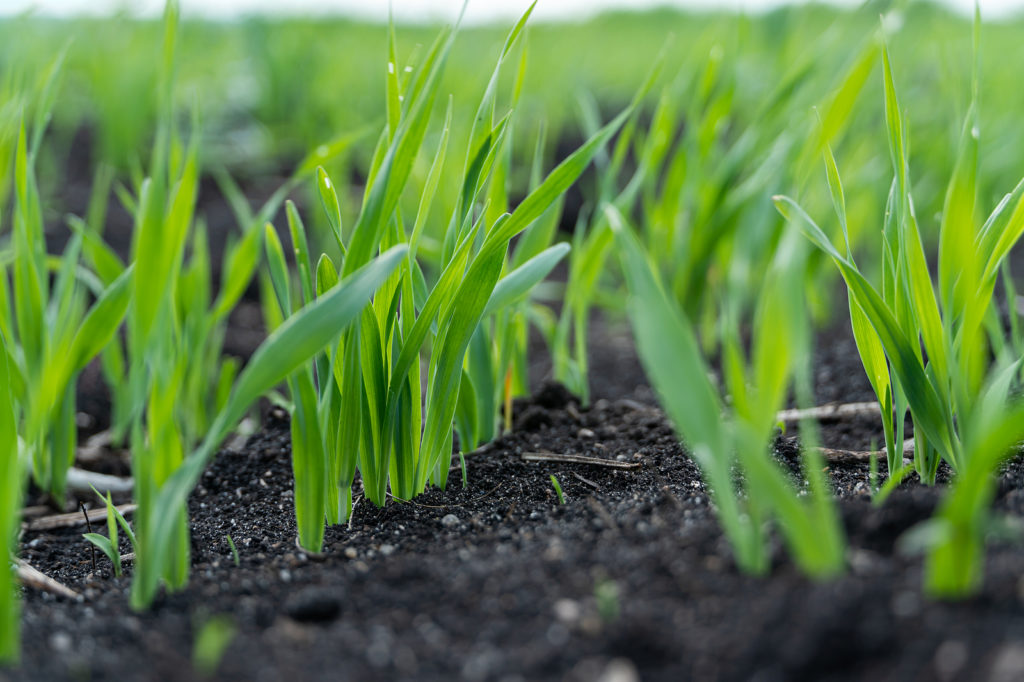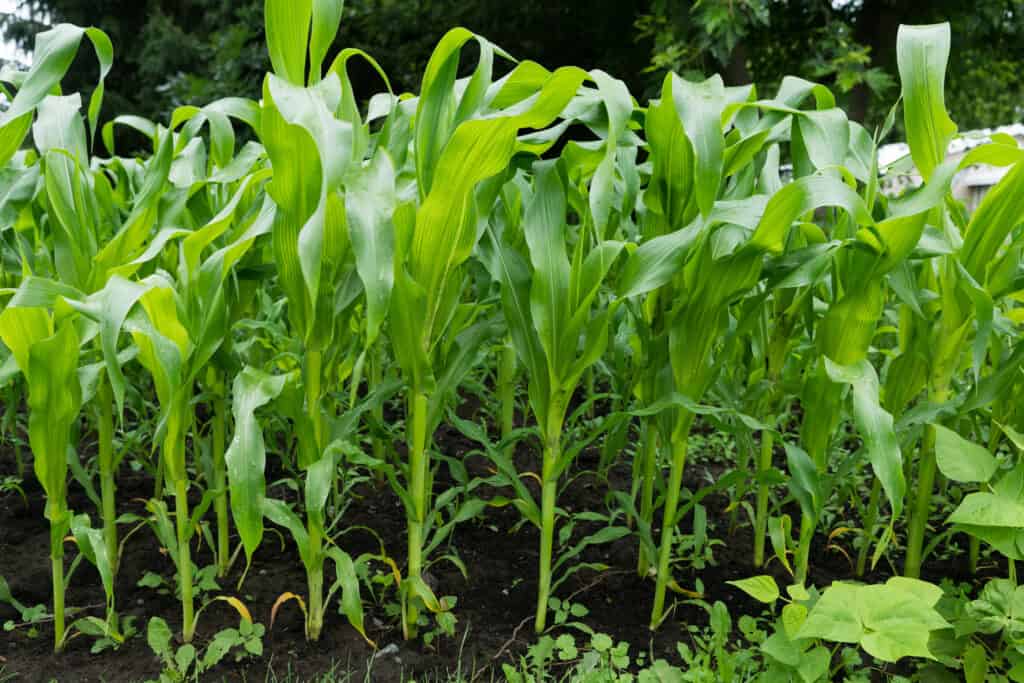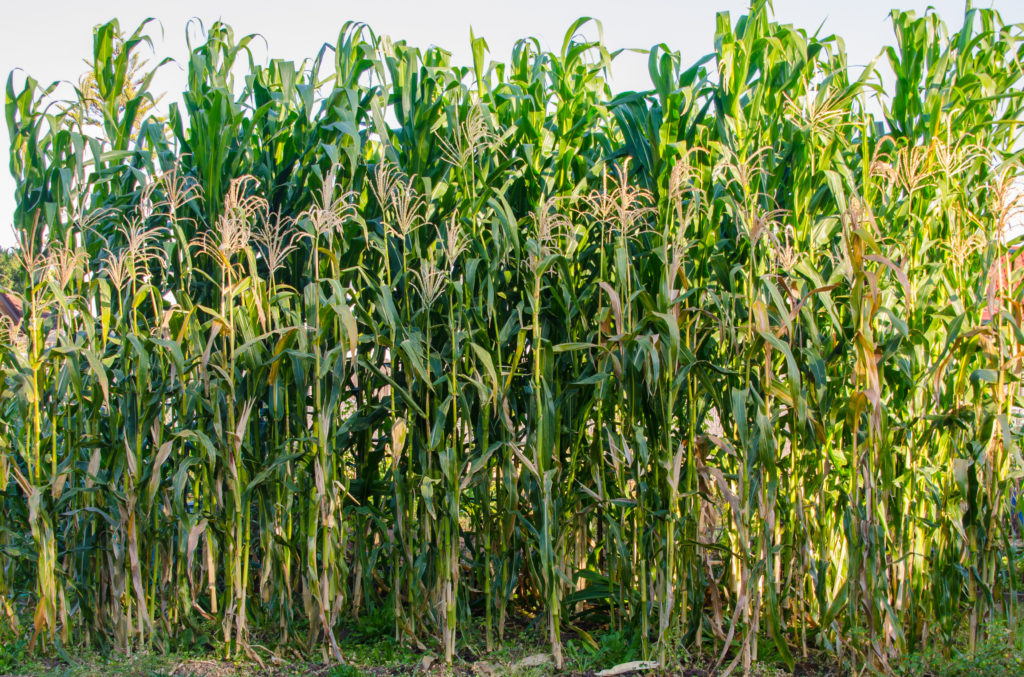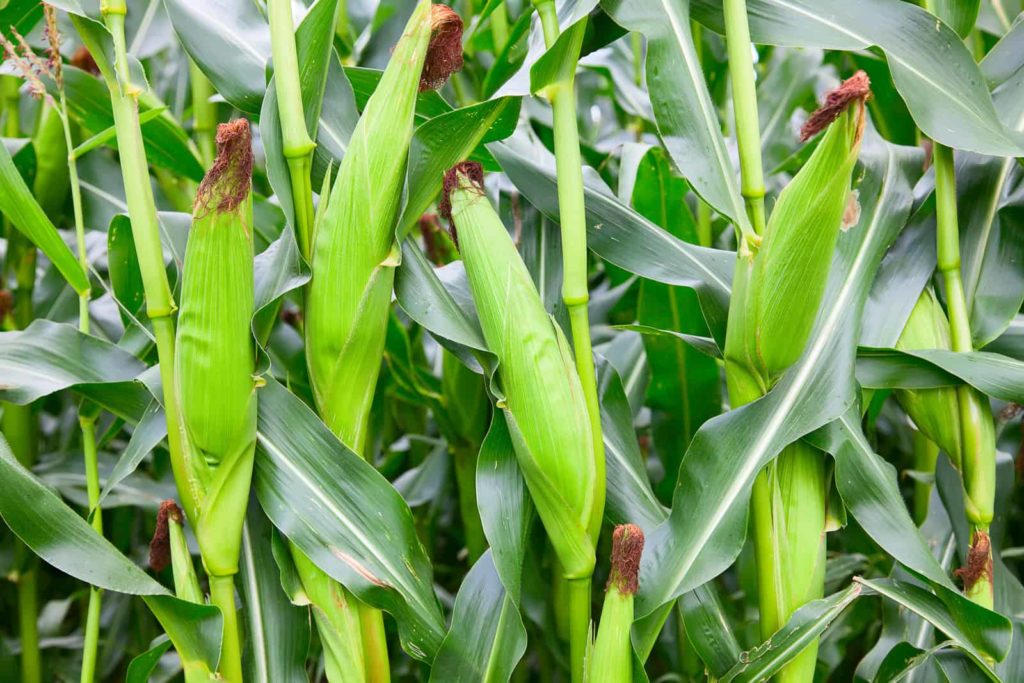Corn is one of the most rewarding crops you can grow in a home garden. Whether you’re planting sweet corn for summer barbecues, ornamental corn for autumn decor, or popcorn for cozy movie nights, growing corn brings both beauty and bounty to your garden. After more than 30 years of growing corn, I’ve learned what works—and what doesn’t—in a home garden. This guide is packed with practical, experience-based advice to help you grow strong, productive corn from seed to harvest.
Three Types of Sweet Corn
Sweet corn varieties fall into three main types based on flavor and sugar content: standard (SU), sugary-enhanced (SE), and supersweet (SH2). These types didn’t just appear overnight—they’re the result of decades of plant breeding and selection aimed at improving flavor, texture, and shelf life. Standard sweet corn (SU) is the classic heirloom type many of our grandparents grew—known for its rich, corny flavor and need to be eaten quickly after harvest. Sugary-enhanced (SE) varieties came next, developed to hold their sweet flavor a little longer—typically up to three days—giving home gardeners a bit more harvest flexibility. Then came supersweet (SH2) corn, a modern innovation boasting ultra-sweet flavor and an even longer shelf life. Each type has specific traits that influence when you can plant, how quickly it matures, and how long it stays sweet once picked. Whether you’re after old-fashioned corn flavor or the sweetest kernels you’ve ever tasted, there’s a type for every taste and growing condition!
Sweet corn comes in three main types:
- Standard (su): Traditional corn with old-fashioned flavor; best eaten shortly after harvest.
- Sugary-enhanced (se): Sweeter than standard, with a slightly longer shelf life.
- Supersweet (sh2): Extra sweet and crisp, with longer storage but less tolerance to cool soil.
Each type has its pros and cons. I grow a mix for staggered harvests and varied flavors.

Sweet Corn Quick Growing Guide
Sweet corn grows best when planted in warm soil with a minimum temperature of 60°F. Choose a location that gets full sun—at least 6 hours daily—and prepare well-drained, fertile soil. Sow seeds 8 to 10 inches apart in rows or blocks to ensure good pollination. Keep the soil evenly moist, providing 1 to 1.5 inches of water per week. Depending on the variety, sweet corn is ready to harvest in 60 to 100 days.
- Soil temperature for planting: 60°F minimum
- Sunlight: Full sun (6+ hours daily)
- Soil: Well-drained, fertile
- Spacing: 8-10 inches apart in rows or blocks
- Watering: 1-1.5 inches per week
- Time to harvest: 60-100 days depending on variety
Where to Plant Sweet Corn
Corn thrives in full sun—at least six to eight hours daily—and it needs room to grow tall and strong. I always select a location with good air circulation but some protection from strong winds, such as near a fence or tall companion crops. Avoid low-lying areas where water tends to pool, as soggy soil can stunt growth or invite disease. One of my key lessons over the years has been rotating crops yearly; it helps prevent soil-borne pests and diseases from gaining a foothold. Healthy soil and thoughtful planning give sweet corn the best start.
- Corn needs full sun and plenty of space.
- Choose a spot protected from wind, and avoid low-lying areas where water collects.
- Rotate crops yearly to reduce disease buildup.
Sweet Corn Planting Time
Sweet corn should be planted after the last frost date, once the soil has warmed to at least 60°F. In cooler climates, it’s best to wait until the weather is consistently warm to ensure strong germination. For a steady supply of fresh corn throughout the season, try succession planting every two weeks. This simple timing strategy can extend your harvest window and keep your kitchen stocked with sweet ears well into late summer.
- Plant after the last frost when soil is at least 60°F.
- In cool climates, wait for consistently warm weather.
- Succession plant every two weeks for a longer harvest.

Planting and Spacing Sweet Corn
I’ve found that proper spacing and planting technique make a big difference in the quality of your harvest. For the best results, plant seeds 1 to 1.5 inches deep and space them 8 to 10 inches apart. Rather than planting in long single rows, use blocks of at least four short rows—this method greatly improves pollination and leads to fuller, better-developed ears. This simple change in layout can really elevate your corn-growing success.
- Plant corn 1 to 1.5 inches deep, 8-10 inches apart.
- Instead of single rows, plant in blocks of at least four short rows. This improves pollination and ear development.
Sweet Corn Pollination
Corn is wind-pollinated, so how you plant it plays a key role in your harvest. Pollination happens when pollen from the tassels drifts down to reach the silks of each developing ear. If pollination is incomplete, you’ll see ears with missing kernels. Planting corn in blocks rather than single rows encourages better pollen distribution, leading to fuller, more consistent ears. A thoughtful layout can make all the difference in producing sweet, plump corn.
- Corn is wind-pollinated, so good layout matters.
- Pollination occurs when pollen from the tassel reaches the silks of each ear.
- Incomplete pollination leads to missing kernels.
Planting Corn in Blocks
Blocks improve pollination compared to single rows. A layout of 4×4 or more ensures pollen reaches all plants.
Hand Pollinating Corn
In poor pollination years, I use a soft brush to collect pollen from tassels and dust it onto silks. It’s easy and very effective.
Corn Cross-Pollination
Sweet corn can cross-pollinate with field or popcorn, affecting flavor and texture. Keep different types 250 feet apart or stagger planting dates to avoid overlap.

Watering Sweet Corn
Corn is a thirsty crop that needs consistent moisture to thrive, especially during the critical stages of tasseling and ear development. Aim to water deeply, providing about 1 to 1.5 inches of water per week, depending on rainfall and soil conditions. Shallow watering can lead to shallow roots and uneven growth. I’ve found that using a soaker hose works best—it delivers water directly to the soil, keeping the leaves dry and reducing the risk of fungal disease. Consistent moisture supports strong stalks, full ears, and sweet, juicy kernels at harvest. Don’t let your corn dry out when it needs it most!
- Corn is thirsty.
- Water deeply 1-1.5 inches per week, especially during tasseling and ear development.
- I use a soaker hose to maintain consistent moisture without wetting leaves.
Fertilizing Sweet Corn
Corn is a heavy feeder that especially loves nitrogen, which fuels its rapid growth and helps produce strong stalks and full ears. Over the years, I’ve learned that prepping the soil before planting makes a big difference—mixing in plenty of compost not only adds nutrients but also improves soil structure and moisture retention. Once the plants reach about 12 inches tall, I side-dress with a nitrogen-rich organic fertilizer, such as blood meal or fish emulsion, to give them a strong mid-season boost. I repeat this again at tasseling, when the plants are gearing up to produce ears. It’s important not to overdo it though—too much nitrogen can lead to lush leaves but weak stalks that are prone to falling over. Balanced feeding and timing are key to growing strong, productive corn.
- Corn loves nitrogen.
- Mix compost into the soil before planting, then side-dress with nitrogen fertilizer when plants are 12 inches tall and again at tasseling.
- Avoid over-fertilizing, which can cause weak stalks.
Sweet Corn Companion Plants
Sweet corn grows best alongside a few reliable companions that can help improve growth, deter pests, and make the most of your garden space. One of the most well-known companions is pole beans, which climb the corn stalks and add nitrogen to the soil—this classic pairing comes from the traditional “Three Sisters” method, which also includes squash. Squash plants sprawl at the base, shading the soil to retain moisture and suppress weeds while their prickly vines help deter raccoons and other pests. Other good companions include cucumbers, dill (which attracts beneficial insects), and marigolds, which help repel harmful insects. I’ve had great success planting basil nearby as well—its strong scent can confuse pests and it’s handy to have for summer cooking. Avoid planting corn near tomatoes or brassicas like broccoli, which can compete for nutrients and stunt growth.
Corn pairs well with:
- Beans (fix nitrogen)
- Squash (shades soil)
- Marigolds (deter pests) Avoid planting near tomatoes and brassicas, which compete for nutrients.

Sweet Corn Care
Caring for sweet corn throughout the growing season is key to a strong, productive harvest. Based on over 30 years of organic gardening experience, I’ve found that keeping young corn weed-free is critical—early competition can stunt growth. As stalks grow, I hill soil around the base to provide support, especially in windy conditions. Stay alert for signs of pests or disease; early detection makes organic treatment much more effective. I always rotate my corn crop each year to reduce disease pressure and soil nutrient depletion. With consistent attention and a few proactive steps, you can enjoy tall, healthy stalks and full, flavorful ears.
- Keep corn weed-free, especially when young.
- Hill soil around the base to support tall stalks.
- Watch for pests and treat early.
- Rotate crops annually.
Lodging Corn
Lodging is when corn stalks fall over due to wind, heavy rain, or weak root systems, and it can seriously impact ear development and yield. I’ve seen it happen most often when corn is over-fertilized with nitrogen, which causes fast but weak growth. To prevent lodging, I always plant corn in blocks rather than single rows—this helps stalks support each other and improves pollination. Hilling soil around the base of the plants when they’re about knee-high gives the roots more stability and protection against strong gusts. These simple steps go a long way in keeping your corn upright and thriving through the season.
- Lodging is when stalks fall over from wind or rain.
- Avoid this by planting in blocks, hilling soil at the base, and avoiding excess nitrogen.
Container-Growing Sweet Corn
Growing corn in containers is entirely possible, especially when choosing dwarf varieties that are well-suited for smaller spaces. To ensure success, opt for large containers, at least 24 inches wide, to allow enough room for the roots to grow. Fill the pots with rich, well-draining soil to provide the necessary nutrients for healthy plants. It’s important to plant corn in blocks, as this helps with pollination, which is typically done by hand in container gardens to ensure a successful harvest. With these steps, you can enjoy fresh homegrown corn even in limited space.
- Yes, you can grow corn in containers—especially dwarf varieties.
- Use large pots (at least 24 inches wide), rich soil, and plant in blocks.
- Hand-pollination is usually needed.
Sweet Corn Pests
Dealing with sweet corn pests is crucial to maintaining a healthy crop. Corn earworms are one of the most common pests, often found feeding on the developing ears. To control them, check the silks regularly and remove any affected ears. Cutworms can damage young corn seedlings by cutting them off at the soil level. Prevent cutworm damage by using collars around the base of plants or applying diatomaceous earth. Aphids can also be a problem, causing stunted growth and spreading diseases. Control aphids by introducing beneficial insects like ladybugs, or use neem oil or other organic sprays. Regular monitoring and early intervention are key to keeping your sweet corn pest-free and thriving.
Watch for:
- Corn earworms
- Cutworms
- Aphids Control with neem oil, beneficial insects, or organic sprays. Check silks and ears regularly.
Sweet Corn Diseases
Controlling diseases is essential for a healthy sweet corn crop. Common diseases like rust, smut, and leaf blight can significantly affect your yield. To prevent these issues, it’s important to practice crop rotation and space your plants properly, which helps reduce the spread of soil-borne diseases. Additionally, selecting disease-resistant varieties can provide an extra layer of protection. Regularly inspecting your corn plants for signs of disease, such as discolored or deformed leaves, can allow for early intervention. By combining preventative measures and vigilant monitoring, you can minimize the impact of diseases and ensure a productive harvest.
Common diseases include:
- Rust
- Smut
- Leaf blight Prevent by rotating crops, spacing properly, and choosing resistant varieties.
Sweet Corn Harvest
I’ve found that the best time to harvest is when the silks turn brown and dry. To check for readiness, peel back the husk and gently press a kernel; if it releases milky juice, it’s ripe and ready for picking. For the best flavor, I always harvest corn in the morning, when the sugars are at their peak. This simple method ensures a fresh, flavorful harvest every time.
- Corn is ready when silks turn brown and dry.
- Peel back the husk and press a kernel—if it spurts milky juice, it’s ready.
- Harvest in the morning for the best flavor.
Storing and Preserving Sweet Corn
Sweet corn tastes best when eaten right after picking, so I always try to enjoy it within a day or two for the freshest flavor. For longer storage, I blanch and freeze dozens of ears each year, ensuring I have sweet, homegrown corn for soups and side dishes throughout the winter. This method helps preserve the flavor and texture, allowing me to enjoy the fruits of my labor long after the growing season ends.
- Corn tastes best right after picking.
- Eat corn within a day or two, or blanch and freeze.
- I freeze dozens of ears each year for soups and sides all winter.
Sweet Corn Kitchen Use
Fresh corn is incredibly versatile and adds a burst of sweetness to many dishes. For a smoky flavor, try grilling the ears with the husks on, or boil them for a classic, tender side dish. If you’re looking to switch things up, cut the kernels off the cob and toss them into salads for a fresh, crunchy element. Corn also shines in hearty chowders, adds a savory touch to cornbread, or brings a vibrant twist to fresh salsa. With so many delicious options, fresh corn is an easy way to elevate your meals.

Sweet Corn Varieties
When it comes to growing corn, there’s a variety for every taste and garden need. Explore the classic flavors of Standard varieties like Golden Bantam and Country Gentleman, known for their rich, traditional taste. For a sweeter experience, Sugary-Enhanced types like Ambrosia and Bodacious offer a longer shelf life while maintaining their delicious flavor. Supersweet varieties, such as Honey ‘n Pearl and Illini Xtra Sweet, provide ultra-sweet kernels perfect for fresh eating. If you’re looking for something unique, try Baby Corn like Minipop, ideal for small, tender ears, or experiment with Popcorn varieties like Strawberry and Dakota Black for a fun, homegrown snack. For a stunning garden addition, Ornamental types like Glass Gem and Indian Flint offer colorful, decorative ears. Whether you’re growing for flavor, fun, or aesthetics, there’s a corn variety to suit your needs.
Explore these types:
- Standard: Golden Bantam, Country Gentleman
- Sugary-Enhanced: Ambrosia, Bodacious
- Supersweet: Honey ‘n Pearl, Illini Xtra Sweet
- Baby Corn: Minipop
- Popcorn: Strawberry, Dakota Black
- Ornamental: Glass Gem, Indian Flint
Corn Varieties by Harvest Time
Choosing sweet corn by harvest season ensures a steady supply throughout the summer and into early fall. Early-season varieties like ‘Early Sunglow’ and ‘Sugar Buns’ mature quickly—perfect for short growing seasons or getting a jump start on the harvest. Midseason varieties such as ‘Golden Bantam’ and ‘Butter and Sugar’ strike a balance between flavor and yield, thriving in most climates. Late-season varieties like ‘Kandy Korn’ and ‘Silver Queen’ take longer to mature but reward you with large, flavorful ears just as the season winds down. For continuous harvests, stagger plantings every two to three weeks using a mix of early, mid, and late-season cultivars.
- Early maturing: 60-70 days
- Mid-season: 75-85 days
- Late: 85-100 days
- Plant a mix for staggered harvests and longer picking season.
These classic corn varieties have stood the test of time for their flavor, reliability, and performance in home gardens. Whether you’re looking for an early harvest, rich heirloom taste, or late-season sweetness, these favorites offer something for every gardener.
- ‘Early Sunglow‘ – A reliable early-season corn with short stalks and 7-inch ears; great for cool climates and small spaces. Days to maturity: 63. Ideal for home gardens.
- ‘Sugar Buns’ (se) – A sweet, tender, sugary-enhanced (se) corn with creamy kernels and excellent flavor. Days to maturity: 70–75. Perfect for home gardens.
- ‘Golden Bantam‘ – An heirloom favorite with rich, old-fashioned corn flavor and 5- to 7-inch ears. Days to maturity: 80. Well-suited for home gardens.
- ‘Butter and Sugar’ (se) – A bicolor variety with creamy texture and sweet flavor, combining white and yellow kernels. Days to maturity: 78. Popular and easy to grow in home gardens.
- ‘Kandy Korn’ (se) – Known for its reddish stalks, long ears, and rich, sweet flavor; retains sweetness well after harvest. Days to maturity: 85–89. Grows well in home gardens.
- ‘Silver Queen’ (su) – A classic late-season white corn with large, sweet ears; best harvested at peak ripeness. Days to maturity: 92. Can be grown in home gardens with a long enough season.
Recommended Varieties
These are my favorite sweet corn varieties for specific reasons that cater to both my gardening preferences and culinary needs. For flavor, I love Ambrosia (se) because of its perfect balance of sweetness and tenderness, making it a true delight to eat fresh from the cob. For yield, Bodacious (se) is a standout, as it consistently produces high quantities of large, delicious ears, making it a reliable choice for those looking to harvest a substantial crop. When it comes to fun and visual appeal, Glass Gem (ornamental) is my go-to; its vibrant, multicolored kernels are not only beautiful but also add an interesting touch to my garden. Lastly, for containers, I prefer On Deck (dwarf sweet corn) because of its compact size and impressive ability to thrive in smaller spaces, making it ideal for growing in pots or limited garden areas. Each variety serves a unique purpose, enhancing both the gardening experience and the enjoyment of homegrown corn.
Here’s my personal favorites list—reliable, flavorful, and just plain fun to grow! These varieties consistently shine in home gardens across a range of climates and growing conditions:
- ‘Avalon’ – A standout white corn with tender, sweet kernels and excellent disease resistance. It’s ready in about 82 days and never disappoints.
- ‘Big N’ Tender’ – This bicolor beauty combines bold flavor with strong resistance to common corn diseases. A solid pick for any garden, maturing in 79 days.
- ‘Cafe’ – One of the best choices for early planting in cool soil, this fast-maturing yellow corn (68 days) is both flavorful and vigorous.
- ‘Glass Gem’ – A showstopper in the garden, this ornamental variety produces rainbow-colored ears that are as stunning as they are versatile—great for popping or grinding.
- ‘Sugar Buns’ – True to its name, this sugar-enhanced corn has a delicious, creamy-sweet flavor and reliable disease resistance. It matures in 70 to 80 days and is a backyard favorite year after year.
Whether you’re after early harvests, ornamental flair, or rich flavor, these varieties are sure to bring success and satisfaction to your summer corn patch!
My favorites:
- For flavor: Ambrosia (se)
- For yield: Bodacious (se)
- For fun: Glass Gem (ornamental)
- For containers: On Deck (dwarf sweet corn)
More About Sweet Corn
Want to go deeper? Check out these related guides:
🌽 Related Posts: Explore More on Growing Corn
🌱 Getting Started with Corn
- Starting Sweet Corn from Seed: Proven Tips for Early Success
- When and Where to Plant Sweet Corn for the Best Yield
- Planting Sweet Corn: Spacing, Block Planting, and Depth Tips
- Can You Grow Corn in Containers? Yes-Here’s How
💧 Watering, Feeding, Pollination & Care
- How to Water and Fertilize Sweet Corn for Maximum Yield
- Sweet Corn Pollination: Natural and Hand-Pollination Tips
- The Best Companion Plants for Sweet Corn (And What to Avoid)
- What To Do When Corn Falls Over (Lodging Tips)
🌽 Harvest, Storage & Serving
- How to Harvest and Store Sweet Corn
- How to Store Fresh Corn and Preserve It for Later
- Seven Easy Wasy to Cook and Serve Sweet Corn
🐛 Pests, Diseases & Troubleshooting
🌟 Sweet Corn Varieties
More how to grow articles:
Learn how to plant, grow, and harvest your favorite vegetables. Click below for all you need to know.
- Artichoke
- Arugula
- Asparagus
- Beans, Snap
- Beets
- Broad Beans
- Broccoli
- Brussels Sprouts
- Cabbage
- Cantaloupe — Melons
- Cardoon
- Carrots
- Cauliflower
- Celeriac
- Celery
- Chard
- Chayote Squash
- Chickpeas
- Chicory
- Chinese Cabbage
- Collards
- Corn Salad
- Corn, Sweet
- Cresses
- Cucumbers
- Eggplant
- Endive and Escarole
- Fava Beans
- Florence Fennel
- Garbanzo Beans
- Garlic
- Horseradish
- Jerusalem Artichoke
- Kale
- Kohlrabi
- Leeks
- Lettuce
- Lima Beans
- Melons
- Mizuna
- Mustard Greens
- New Zealand Spinach
- Okra
- Onions
- Parsnips
- Peanuts
- Peas
- Peppers
- Potatoes
- Pumpkins
- Radicchio
- Radishes
- Rhubarb
- Rutabaga
- Salsify
- Shallots
- Sorrel
- Southern Peas
- Soybeans
- Spinach
- Squash, Summer
- Squash, Winter
- Sunchokes
- Sweet Potato
- Swiss Chard
- Taro
- Tomatillo
- Tomatoes
- Turnips
- Watermelon
- Zucchini



